Citrus Black Spot Pest Profile
Pest Profile
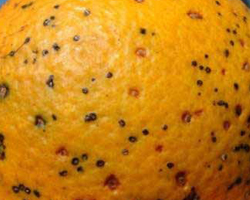
Photo credit: USDA – APHIS
Description
Citrus black spot (CBS) is a plant disease caused by the fungus Phyllosticta citricarpa. This name describes the imperfect stage; it is also known by its perfect stage, Guignardia citricarpa. Both forms produce infective spores. Symptoms are primarily on the fruit, with unsightly dark lesions formed on the rind, which reduces the fresh market crop value. All commercial citrus varieties are susceptible, but late-maturing cultivars and lemons are most vulnerable.
History
CBS was originally found on citrus in Australia in 1895. International spread is assumed to have taken place mainly through the movement of infected plants for planting, rather than with infected fruit. By the late 1970s it was established in Southern Africa and described as an “epidemic and a major crop destroyer.” In 2010, the United States Department of Agriculture (USDA) Animal and Plant Health Inspection Service (APHIS) confirmed the first CBS detection in the United States in Collier County, Florida, in a commercial orange grove. Unable to eradicate the disease, today the USDA maintains a Federal domestic quarantine against six infested counties in Florida https://www.fdacs.gov/content/download/10168/file/DA-2012-09federalorder.pdf.
Distribution
In the United States, CBS is established in southern Florida. The disease is not known to be in widespread in the Caribbean or Mexico, although it has been intercepted in fruit from Cuba. It does occur in many tropical citrus producing countries in Asia, Africa, Australia, and parts of South America including Brazil.
Symptoms
Symptoms on mature leaves and petioles are circular red to red-brown spots, visible on both leaf surfaces. Small spots ( <3 mm), darken with a brown to black ring. Leaf lesions can have yellow halos. CBS produces similar symptoms to those caused by other pathogens, and mechanical or insect damage. Diagnosis should not be made on field symptoms alone. Symptoms on fruit have multiple descriptions including black spot, hard spot, shot hole spot, false melanose, speckled blotch, freckle spot, and virulent spot.
Most symptoms do not appear for several months after infection, usually not until the fruit begins to ripen. Spores form in fruit lesions, leaves, and twigs. The spores are spread by wind driven rain and rain splash and can reinfect fruit and leaves. The Phyllosticta form can produce multiple cycles of infective conidiospores. The disease is favored by warm, humid weather with frequent rainfall during the summer. In order to infect, the fungus requires a long wetting period of 24–48 hours.
Lesions on Leaves
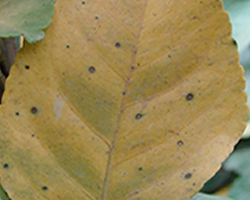
Photo credit: USDA – APHIS
Young leaf lesions are small, round, slightly raised, reddish-brown with light centers, and a diffuse yellow halo. Older lesions are sunken, with a gray center and dark brown margin.
Lesions on Fruit
Lesions on fruit are diverse and grouped by symptom names.
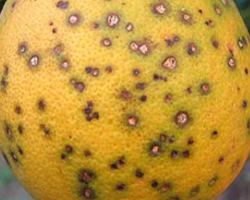
Photo credit: USDA – APHIS
Hard Spot
Hard spot is the most typical symptom of CBS on fruit. Symptoms appear as the fruit matures, often around the time of color change, as circular depressions that are 310 mm (0.12 -0.4 inch) in diameter. Lesions have tan to gray centers with a distinct or prominent brick-red to dark brown margin. Lesions develop on the side of the fruit most exposed to sunlight.
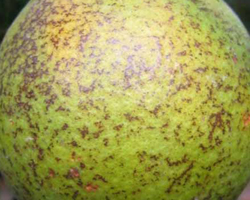
Photo credit: USDA – APHIS
False Melanose
False melanose symptoms appear as numerous, small lesions that are dark brown, raised, and less than 1 mm (0.04 inch) in diameter. These lesions are much smaller than hard spot lesions. False melanose occurs on green fruit.

Photo credit: USDA – APHIS
Freckle Spot
Freckle spot lesions are round, depressed lesions that are 1-3 mm (0.04 -0.12 inch) in diameter, and reddish in color. This symptom is considered a sign of a heavy infection. Freckle spot lesions can remain as single lesion or coalesce to form the virulent spot type of lesion late in the season or during storage.
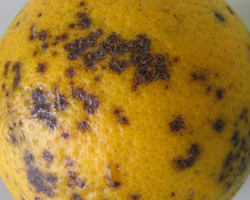
Photo credit: USDA – APHIS
Cracked Spot
Cracked spot lesions are dark, smooth, and vary in size with irregular margins and a cracked surface, often forming on green fruit and remain visible on mature fruit. This symptom has only been observed in the Americas and can be associated with rust mite damage.
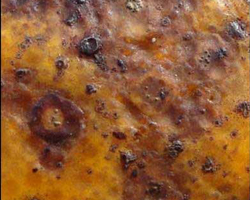
Photo credit: USDA – APHIS
Virulent Spot
Virulent spot lesions occur on heavily infected, mature fruit towards the end of the growing season. These lesions are necrotic, sunken, irregular, and cover a large area of the fruit. This symptom is caused by the expansion and/or fusion of other lesions. Virulent spot may be accompanied by premature fruit drop and serious post-harvest damage because the lesions may extend into the fleshy part of the fruit.
References
- Tran, N, T., Miles, A K., Dietzgen, R, G., Dewdney, M, M., Zhang, K., Rollins, J, A., Drenth, A. (2017, April 07), Sexual Reproduction in the Citrus Black Spot Pathogen Phyllosticta citricarpa. In https://apsjournals.apsnet.org/ from. Retrieved 2021, April 09 from https://apsjournals.apsnet.org/doi/full/10.1094/PHYTO-11-16-0419-R
- Center, C. R. A. E. (2019, June 27). Black Spot -University of Florida, Institute of Food and Agricultural Sciences. Https://Crec.Ifas.Ufl.Edu/. https://crec.ifas.ufl.edu/citrusproduction/plant-pathology-/black-spot/
- Chung, K. R., Peres, N. A., & Timmer, L. W. (2005, September 1). Citrus Diseases Exotic to Florida: Black Spot. Http://Www.Keyplex.Com/Wp-Content/Uploads/ResearchTopics/Citrus/Citrus-Black-Spot.Pdf. https://edis.ifas.ufl.edu/
- U. (n.d.). Citrus black spot. Retrieved April 09, 2021, from https://www.aphis.usda.gov/aphis/ourfocus/planthealth/plant-pest-and-diseaseprograms
